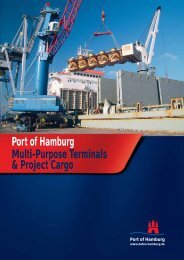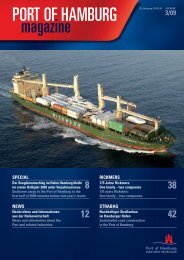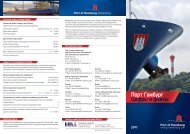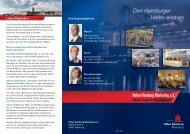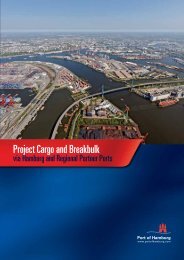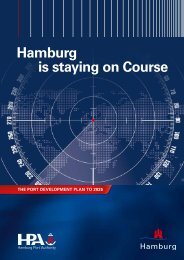Port of Hamburg Magazin 03 - Hafen Hamburg
Port of Hamburg Magazin 03 - Hafen Hamburg
Port of Hamburg Magazin 03 - Hafen Hamburg
- Keine Tags gefunden...
Sie wollen auch ein ePaper? Erhöhen Sie die Reichweite Ihrer Titel.
YUMPU macht aus Druck-PDFs automatisch weboptimierte ePaper, die Google liebt.
90.<br />
The Great Jubilee Special<br />
Since the foundation in 1920, the<br />
name Buss is well known in the<br />
<strong>Port</strong> <strong>of</strong> <strong>Hamburg</strong>. Today, the<br />
name stands for a diversified, innovative<br />
and reliable service group in<br />
the worldwide logistics. Since the<br />
mid-1990s, the company expanded<br />
its port services with further activities.<br />
Das Buss Hansa Terminal – die Adresse für Umschlag von<br />
Gütern jeder Art./The Buss Hansa terminal is the first choice<br />
when it comes to the turnover <strong>of</strong> goods <strong>of</strong> all sorts.<br />
Handling nach Maß, bei jeder Art von<br />
Ladung – damals wie heute eine Kern -<br />
kompetenz von Buss./The customised<br />
handling during each shipment allways<br />
was a core competence <strong>of</strong> Buss.<br />
Fotos: Buss<br />
1920: Foundation and beginning <strong>of</strong> a period<br />
<strong>of</strong> rapid growth<br />
Gerhard (Gerd) Buss from East Frisia has set<br />
up the company on August 1, 1920 and brings<br />
in his brother Hinrich as partner one year<br />
later. Already in the beginning <strong>of</strong> the 30s<br />
Buss belongs to one <strong>of</strong> the leading stevedoring<br />
companies. Its customers include more<br />
than 20 national and international shipping<br />
lines as well as a number <strong>of</strong> well-known<br />
tramp charterers. He employs up to 1000<br />
stevedores, as they were formerly called, on<br />
individual days. One <strong>of</strong> them is Erwin Seeler,<br />
the father <strong>of</strong> the later soccer idol Uwe Seeler.<br />
40s and 50s: Reconstruction and<br />
economic miracle<br />
With the outbreak <strong>of</strong> World War II, the wave<br />
<strong>of</strong> globalization <strong>of</strong> the 20s and 30s and, thus,<br />
the activity <strong>of</strong> the Gerd Buss stevedoring<br />
company ends abruptly. In 1945, Gerd Buss<br />
stevedoring company resumes its activity in<br />
a largely destroyed <strong>Port</strong> <strong>of</strong> <strong>Hamburg</strong> and is<br />
able to regain his customers gradually. In<br />
1946, Jürgen Buss, the son <strong>of</strong> Hinrich, becomes<br />
another partner. During the years <strong>of</strong> the<br />
economic miracle, the company reached its<br />
climax with the booming German export.<br />
Among other things, Buss takes over the<br />
handling <strong>of</strong> Volkswagen in the <strong>Port</strong> <strong>of</strong><br />
<strong>Hamburg</strong> and later also in Emden.<br />
60s: The container revolutionises cargo<br />
handling<br />
In the second half <strong>of</strong> the 60s radical changes<br />
are caused. The container was the industrial<br />
revolution for the previously labor-intensive<br />
and mostly manually operated conventional<br />
transportation and handling <strong>of</strong> cargo.<br />
Transportation becomes many times chea-<br />
per, faster and more reliable and secure.<br />
The container makes the classical stevedoring<br />
company, the core business <strong>of</strong> Buss,<br />
needless. In order to remain active in port<br />
handling, Buss has to “go ashore” and operate<br />
his own terminals. In 1970, together<br />
with the shareholders <strong>of</strong> the shipping company<br />
Aug. Bolten, Dr. Johan Adolf Binder<br />
and Dr. Hans Helmut Killinger, he sets up a<br />
financial holding in order to achieve the<br />
required financial strength.<br />
70s: Buss goes ashore<br />
In the 70s, the containerisation rapidly gains<br />
momentum. While it was formerly assumed<br />
that only mainstream transport would be<br />
containerised between the highly developed<br />
industrialised countries such as the U.S.,<br />
Western Europe and East Asia, Buss focused<br />
on the services with other parts <strong>of</strong> the world<br />
that were not containerised. In order to ensure<br />
the continued existence <strong>of</strong> the stevedoring<br />
company, Buss bought several conventional<br />
quay companies. Apart from the Ross quay,<br />
which was operated for many years in a joint<br />
venture with the HHLA (Arge Ross quay),<br />
the Africa, Kuhwerder and Tollerort terminal<br />
were added. Customers from state-owned<br />
shipping companies <strong>of</strong> the Eastern bloc and<br />
from countries <strong>of</strong> the Third World are extremely<br />
important for the Buss terminals.<br />
80s: Hesitant turn towards the container<br />
In the 80s, Buss becomes increasingly involved<br />
with the container. Buss becomes agent<br />
<strong>of</strong> the container leasing company CTI and<br />
operates mobile workshops for maintenance,<br />
repair and sales <strong>of</strong> containers and takes<br />
part in a project regarding the production <strong>of</strong><br />
containers in Cuba. During this time, Buss<br />
also establishes a joint venture with German<br />
Railways for the construction and operation<br />
<strong>of</strong> container yards in the hinterland and<br />
operates 14 depots in Germany and Hungary.<br />
At the end <strong>of</strong> the 80s, the handling <strong>of</strong> container<br />
ships follows and the Tollerort terminal<br />
is transformed into a container terminal.<br />
90s: Radical reconstruction and<br />
new priorities<br />
With the collapse <strong>of</strong> the Eastern bloc and<br />
the rapid industrialization <strong>of</strong> Asia, the conventional<br />
handling <strong>of</strong> cargo comes almost<br />
completely to a standstill within a few years.<br />
At the end <strong>of</strong> the 90s, the level <strong>of</strong> containerisation<br />
in the <strong>Port</strong> <strong>of</strong> <strong>Hamburg</strong> accounts for<br />
95 percent. Buss has to close conventional<br />
terminals and lay <strong>of</strong>f more than 400 employees.<br />
In order to survive, he is forced to sell<br />
part <strong>of</strong> his “silverware” just like the container<br />
terminal Tollerort and his shares in the<br />
inland container yards. Modern logistics<br />
centres are set up in the <strong>Port</strong> <strong>of</strong> <strong>Hamburg</strong><br />
for the Helm AG, Panasonic and other wellknown<br />
customers. In addition, Buss establishes<br />
and operates a modern dangerous<br />
goods warehouse.<br />
2000: A new millennium and again there is<br />
water under the keel<br />
In 2001, the oldest son <strong>of</strong> Dr. Hans Helmut<br />
Killinger, Dr. Johann Killinger, acquires stakes<br />
<strong>of</strong> the Buss group. After the successful<br />
renovation <strong>of</strong> <strong>Hamburg</strong>’s terminals, Buss<br />
begins to expand again. The business area<br />
logistics real estate development will be<br />
renamed Ixocon and expanded throughout<br />
Germany. In 20<strong>03</strong>, the issuing house Buss<br />
Capital, which issues closed funds in the<br />
field <strong>of</strong> logistics, was established. Within a<br />
few years, Buss Capital becomes the leading<br />
market among container funds and an<br />
important financial partner for container<br />
leasing companies. The port activities are<br />
combined under Buss <strong>Port</strong>s. Buss <strong>Port</strong>s<br />
operates multi-purpose terminals for containers,<br />
project cargo and bulk goods in<br />
<strong>Hamburg</strong> and other ports and comprises a<br />
broad <strong>of</strong>fer <strong>of</strong> port-specific services. All<br />
business areas as well as the share in the<br />
shipping company Aug. Bolten are combined<br />
in a holding <strong>of</strong> the Buss Group GmbH &<br />
Co. KG in 2006.<br />
2010: 90 years <strong>of</strong> Buss are set to growth<br />
Focused on the three pillars port, real estate<br />
and funds, the Buss Group, under the leadership<br />
<strong>of</strong> Dr. Johann Killinger, Heinrich<br />
Ahlers and Larissa Dan approaches its 90th<br />
anniversary. Ambitious growth targets are<br />
recorded in all increasingly decentralised<br />
areas. Targeted training and further education<br />
<strong>of</strong> employees play a central role. The<br />
course for the 100th anniversary is set.<br />
PORT OF HAMBURG MAGAZINE 3/10<br />
51




